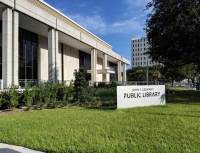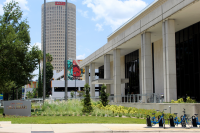Landscaping for Sustainability, Safety and Style
Tampa-Hillsborough County Public Library, Fla.
Innovation Synopsis
Tampa-Hillsborough County Public Library launched a multi-phase landscaping project focused on sustainability and safety. The design choices conserve water with Florida-friendly plants and smart irrigation systems, lower crime risk by creating clear sightlines and provide opportunities to educate the community on sustainable landscaping.
Challenge/Opportunity
Creating a safe, welcoming outdoor space brings challenges in any environment. Florida’s heat, along with its unpredictable weather, make it especially difficult to conserve water while maintaining healthy and appealing landscaping. With 27 branches spread across a large county, Tampa-Hillsborough County Public Library decided to rethink its one-size-fits-all approach to landscaping with a plan that focuses on sustainability and safety while accommodating the unique needs of each location.
Key Elements of Innovation
THPL commissioned a study to determine cost-effective and efficient ways to promote water conservation in its outdoor spaces with Florida-friendly plant species and minimal impact to natural areas. The study incorporated elements of Crime Prevention Through Environmental Design (CPTED), which considers factors such as shrub and tree height to lower risk for crime, and $500,000 in local funds were earmarked for establishing new trees. Phase 1 has begun at its downtown branch, with plans to expand to 20 locations by 2020.
Achieved Outcomes
The new landscaping design features will have immediate impact on sustainability and safety. Replacing invasive species with native and Florida-friendly plants will conserve water and promote healthy growth. CPTED-based shrub and tree choices will provide clear sightlines and deter crime. Smart irrigation systems that only run when needed have the potential to cut water use by as much as 50%. Overall these features create a welcoming environment and serve as an example of green landscaping practices for the community.


